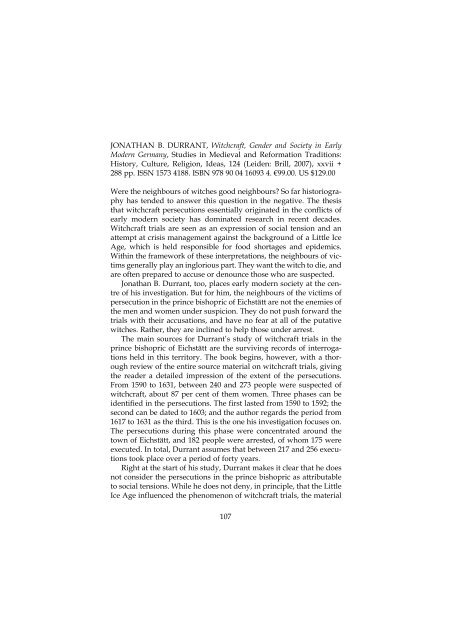Download - German Historical Institute London
Download - German Historical Institute London
Download - German Historical Institute London
You also want an ePaper? Increase the reach of your titles
YUMPU automatically turns print PDFs into web optimized ePapers that Google loves.
JONATHAN B. DURRANT, Witchcraft, Gender and Society in Early<br />
Modern <strong>German</strong>y, Studies in Medieval and Reformation Traditions:<br />
History, Culture, Religion, Ideas, 124 (Leiden: Brill, 2007), xxvii +<br />
288 pp. ISSN 1573 4188. ISBN 978 90 04 16093 4. €99.00. US $129.00<br />
Were the neighbours of witches good neighbours? So far historiography<br />
has tended to answer this question in the negative. The thesis<br />
that witchcraft persecutions essentially originated in the conflicts of<br />
early modern society has dominated research in recent decades.<br />
Witchcraft trials are seen as an expression of social tension and an<br />
attempt at crisis management against the background of a Little Ice<br />
Age, which is held responsible for food shortages and epidemics.<br />
Within the framework of these interpretations, the neighbours of victims<br />
generally play an inglorious part. They want the witch to die, and<br />
are often prepared to accuse or denounce those who are suspected.<br />
Jonathan B. Durrant, too, places early modern society at the centre<br />
of his investigation. But for him, the neighbours of the victims of<br />
persecution in the prince bishopric of Eichstätt are not the enemies of<br />
the men and women under suspicion. They do not push forward the<br />
trials with their accusations, and have no fear at all of the putative<br />
witches. Rather, they are inclined to help those under arrest.<br />
The main sources for Durrant’s study of witchcraft trials in the<br />
prince bishopric of Eichstätt are the surviving records of interrogations<br />
held in this territory. The book begins, however, with a thorough<br />
review of the entire source material on witchcraft trials, giving<br />
the reader a detailed impression of the extent of the persecutions.<br />
From 1590 to 1631, between 240 and 273 people were suspected of<br />
witchcraft, about 87 per cent of them women. Three phases can be<br />
identified in the persecutions. The first lasted from 1590 to 1592; the<br />
second can be dated to 1603; and the author regards the period from<br />
1617 to 1631 as the third. This is the one his investigation focuses on.<br />
The persecutions during this phase were concentrated around the<br />
town of Eichstätt, and 182 people were arrested, of whom 175 were<br />
executed. In total, Durrant assumes that between 217 and 256 executions<br />
took place over a period of forty years.<br />
Right at the start of his study, Durrant makes it clear that he does<br />
not consider the persecutions in the prince bishopric as attributable<br />
to social tensions. While he does not deny, in principle, that the Little<br />
Ice Age influenced the phenomenon of witchcraft trials, the material<br />
107













